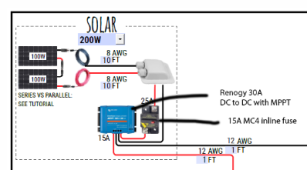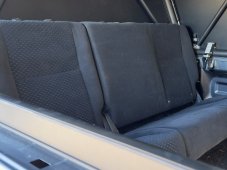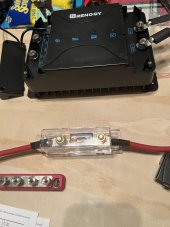SolarJohngo
New Member
- Joined
- Dec 14, 2022
- Messages
- 19
Hello,
New to the forum. I'm installing a 30A MPPT DC-DC Renogy Charge Controller. I picked up
a 100W flexible solar panel kit, a 600W inverter, and a Renogy 100aH lithium battery. There is a
negative and postive bus bar with a kill switch for the postive battery.
I need help understanding the mental fog around fuses.
Currently, I have 2 50A ANL fuses.
I am ordering a 15A MC4 inline fuse
My Amazon list has 2 40A circuit breakers bookmarked ( 1 to the Fuse box, and another coming from the solar into the charger)
I'm working with suggestions from Will Prowse's website for the Renogy 400w system, the diagrams on faroutride.com,
and renogy. And from comparing everything, I guessing as to what to do still. So, I'm a bit new to this.
So, for simplicity with out doing too much damage. I think I could run 4 gauge wires for the most part, put 50ANL fuses from Charge Controller
to house battery and another from starter to charge controller. Could I put a 40A circuit breaker from +Bus to fusebox and another coming from
the solar input on the charge controller? What about a breaker going into the alternator positive of the Charge controller (Renogy DCDC30)? Another 40 to 45 seeing
the Vehicle Input Fuse Rating is 45A?
Once this is all connected in my 2012 Tundra, I will upgrade to a second battery and would like to
add another inverter, or single upgraded inverter, to handle heavier loads like an infrared cooktop pulling up to 1200w
on rare ocassions.
As this is being built out I will be adding another Lithium 100aH at the very least after the holidays.
New to the forum. I'm installing a 30A MPPT DC-DC Renogy Charge Controller. I picked up
a 100W flexible solar panel kit, a 600W inverter, and a Renogy 100aH lithium battery. There is a
negative and postive bus bar with a kill switch for the postive battery.
I need help understanding the mental fog around fuses.
Currently, I have 2 50A ANL fuses.
I am ordering a 15A MC4 inline fuse
My Amazon list has 2 40A circuit breakers bookmarked ( 1 to the Fuse box, and another coming from the solar into the charger)
I'm working with suggestions from Will Prowse's website for the Renogy 400w system, the diagrams on faroutride.com,
and renogy. And from comparing everything, I guessing as to what to do still. So, I'm a bit new to this.
So, for simplicity with out doing too much damage. I think I could run 4 gauge wires for the most part, put 50ANL fuses from Charge Controller
to house battery and another from starter to charge controller. Could I put a 40A circuit breaker from +Bus to fusebox and another coming from
the solar input on the charge controller? What about a breaker going into the alternator positive of the Charge controller (Renogy DCDC30)? Another 40 to 45 seeing
the Vehicle Input Fuse Rating is 45A?
Once this is all connected in my 2012 Tundra, I will upgrade to a second battery and would like to
add another inverter, or single upgraded inverter, to handle heavier loads like an infrared cooktop pulling up to 1200w
on rare ocassions.
As this is being built out I will be adding another Lithium 100aH at the very least after the holidays.












